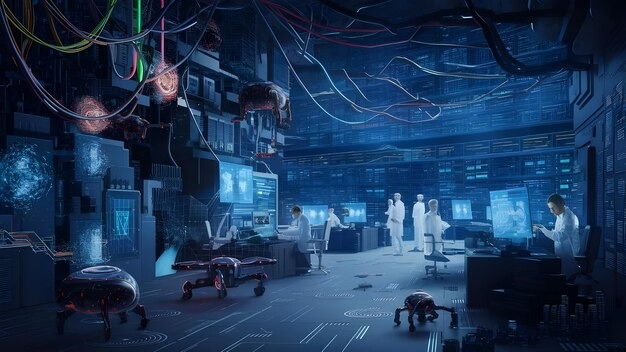As we enter the era of the metaverse, the way we interact with digital content is transforming. A blend of virtual and augmented realities, the metaverse is a highly immersive environment where users can engage with brands, products, and experiences in a virtual space. This growing trend calls for new approaches to visual content, and motion graphics have quickly found their place in shaping these immersive experiences.
In this blog, we’ll explore how motion graphics fit into the metaverse, how businesses can benefit from them, and the future of this exciting intersection between digital design and virtual environments.
What Are Motion Graphics?
Motion graphics combine graphic design elements with animation to create dynamic, engaging visual content. They are typically used in marketing, advertising, education, and entertainment to communicate ideas and messages in a visually appealing and efficient way. Whether in a video, website, or app, motion graphics often serve as a way to make complex ideas more digestible.
As the metaverse evolves, motion graphics services are becoming an essential part of the experience. They help create dynamic environments, enhance user engagement, and allow brands to tell their stories in an interactive way.
The Role of Motion Graphics in the Metaverse
-
Creating Immersive Virtual Environments
In the metaverse, immersive environments are key to providing engaging experiences for users. Motion graphics are used to design and animate elements within these virtual worlds, making them more vibrant and interactive. From 3D logos to animated user interfaces, motion graphics designs help define the visual tone of the metaverse.
These graphics can simulate real-world elements like weather, lighting, and textures, or create completely new fantastical environments. In this way, motion graphics help to bridge the gap between the digital and physical worlds, providing users with an engaging experience that feels almost real.
-
Interactive Storytelling
Traditional storytelling techniques are evolving within the metaverse. Instead of passive viewing, users now actively engage in the narrative. Motion graphics are used to enhance this interaction by creating animated elements that respond to users’ actions.
Whether it’s an explorable brand experience or a virtual event, motion graphics design services bring the environment to life. Users can interact with animated graphics that guide them through a virtual journey, creating a more personalized and memorable experience. This new form of interactive storytelling makes brand communication in the metaverse more dynamic.
-
Enhanced Branding and Marketing
Branding in the metaverse is more than just logos and taglines; it’s about creating an entire world that represents your brand. Motion graphics allow companies to create branded experiences that are not only immersive but also highly interactive.
For example, a brand can use motion graphics to create 3D logos that float in virtual space, interactive product demonstrations, or digital billboards that catch users’ attention in a metaverse city. Motion graphics services enable brands to build virtual identities that stand out and leave a lasting impression.
As more companies establish themselves in the metaverse, the demand for creative and visually appealing content will grow. Motion graphics will be a crucial tool for businesses looking to differentiate themselves and capture users’ attention.
Also read : Integrating a Free Currency API: Best Practices for Developers
Benefits of Using Motion Graphics in the Metaverse
-
Increased Engagement
In a space like the metaverse, where users are constantly moving and interacting, static visuals often fail to capture attention. Motion graphics, on the other hand, are dynamic and engaging, naturally drawing users’ eyes. They provide a way to make virtual environments more interactive and enjoyable, resulting in higher user engagement.
-
Seamless Integration with AR and VR
The metaverse is largely driven by technologies like augmented reality (AR) and virtual reality (VR), and motion graphics fit seamlessly into these environments. They can be used to create virtual signage, interactive dashboards, or 3D animations that enhance a user’s experience in AR or VR spaces.
For instance, in virtual events or exhibitions, motion graphics can guide users through different zones, display live data, or animate product demonstrations in real-time. This level of interaction makes the user experience more fluid and captivating.
-
Cost-Effective and Flexible
Compared to full-scale 3D animation, motion graphics can be a more cost-effective solution for creating engaging content in the metaverse. They are faster to produce and can be easily updated or adapted for different virtual environments.
This flexibility makes motion graphics an ideal tool for businesses looking to maintain a consistent and dynamic presence in the metaverse without investing in highly complex 3D assets every time.
Future of Motion Graphics in the Metaverse
As the metaverse grows, so will the role of motion graphics. The future will likely see more sophisticated use of motion graphics design services as brands and creators push the boundaries of virtual engagement.
One emerging trend is the use of AI-driven motion graphics, where graphics react and evolve based on user behavior in real-time. Imagine a virtual store where the layout and animated elements change dynamically based on the customer’s preferences or browsing history. AI-powered motion graphics could offer personalized experiences like never before.
Another trend is collaborative virtual design, where designers from around the world can co-create motion graphics in real-time within the metaverse. As remote work becomes more common, these virtual workspaces will allow creative teams to collaborate seamlessly on motion graphics projects, regardless of location.
Finally, NFTs (non-fungible tokens) will also play a significant role. Motion graphics as NFTs will allow creators and brands to offer unique, one-of-a-kind animated digital assets that users can collect, trade, and display in the metaverse.
Concluding Thoughts
Motion graphics have found a natural home in the metaverse, where immersive, interactive, and visually engaging content is key. As businesses and brands establish their presence in this virtual space, motion graphics services will be vital for creating dynamic environments, enhancing storytelling, and elevating user experiences.
Whether through branded environments, interactive storytelling, or enhanced AR/VR experiences, motion graphics will continue to evolve as an essential tool in the metaverse. For companies looking to stay ahead in this rapidly growing space, investing in creative and high-quality motion graphics is a smart move.
Also read : Boost Business Performance with Scalable Odoo Web Development



